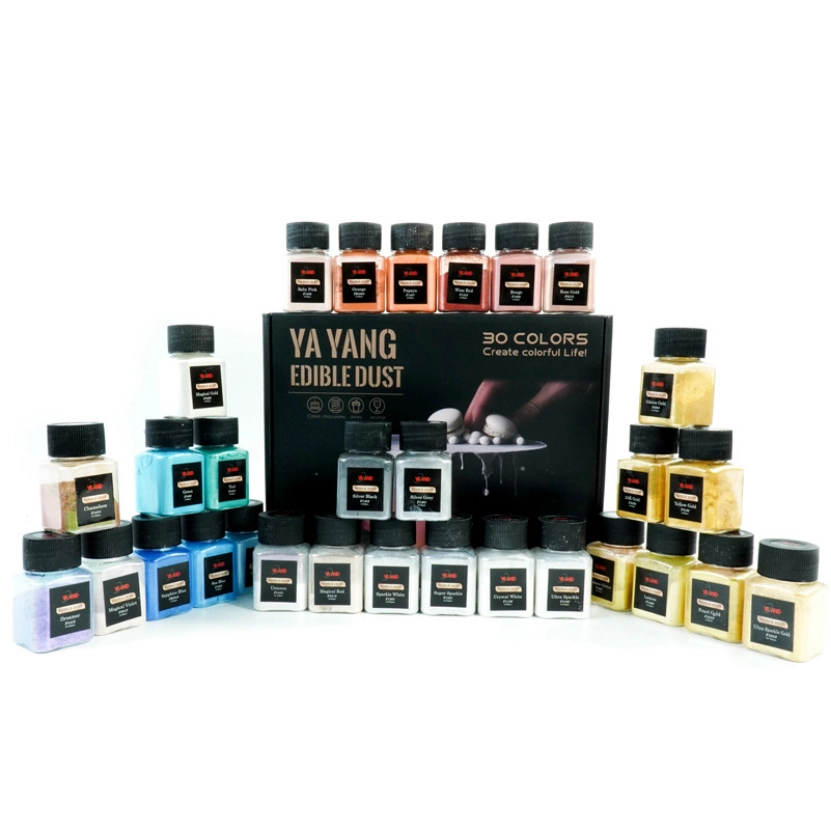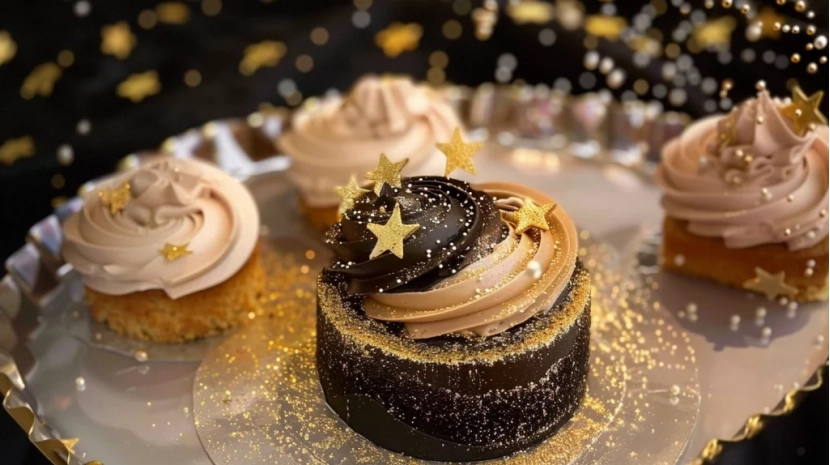
Understanding Edible Luster Dust
What Is Edible Luster Dust and How It’s Made
Edible luster dust is this super sparkly, crazy fine powder that makes food look totally epic with a shiny glow. Unlike plain old food coloring that just slaps on a color, this stuff throws in a bright shade and a glittery shine that makes you go “whoa!” People whip it up by mixing mica-based pigments with safe things, like gluey stuff to hold it together and dyes that are cool for food. They grind it down to a teeny-tiny texture. That’s why it glides so smooth on soft things like fondant, chocolate, or frosting.
Common Ingredients and Safety Standards for Edible Use
The main player in edible luster dust is mica, a natural mineral that snags light and makes it twinkle. To keep it safe for munching, folks coat the mica with dyes that are okay for eating. They stick to real tough rules from groups like the FDA or EFSA. They poke around the powders super close to kick out any bad stuff, like heavy metals, so it’s safe in tiny bits. You gotta know what’s up with “edible” versus “non-toxic” labels. Only dust that says “edible” is good to gobble up.
Differences Between Edible, Non-Toxic, and Decorative Dusts
Edible luster dust is totally not like non-toxic or decorative kinds. The edible kind is made special so you can chomp it without a worry. Non-toxic dusts won’t make you sick right off, but they’re not for eating. They’re awesome for food displays you don’t swallow. Decorative powders are just for looking cool. They’re great for fancy sugar sculptures or cakes you just show off, but don’t even think about eating them.
The Artistic Applications of Edible Luster Dust
Enhancing Visual Appeal in Culinary Creations
Edible luster dust can take dull desserts and make them look like a total rockstar. You can sprinkle a soft glow on macarons or slap a shiny, metallic vibe on chocolates. It adds a fancy feel without messing with the taste or how it feels in your mouth. Try dusting it lightly on fondant shapes or spraying it on buttercream with an airbrush. It makes light effects that pop and make your dessert look like it’s ready for the red carpet.
The Use of Edible Luster Dust in Decorative Arts Beyond Food
Most folks use edible luster dust for baking and making candies. But it’s also super cool for non-food stuff where being safe matters a ton. Think about using it for kids’ clay projects or school crafts that look like food. Since it’s safe, you don’t panic if edible and non-edible things get mixed up. A little nibble by mistake won’t cause a fuss.
Combining Edible Luster Dust with Other Effect Pigments
When you’re mixing stuff, edible luster dust plays nice with other sparkly powders, like glittery or metallic ones, as long as they’re safe for food if you’re gonna eat them. For non-food things, like resin art or nail designs, people toss this dust with wild neon colors, glow-in-the-dark effects, or powders that switch up with heat or light. The result is super bold and makes everyone stare, with looks that change depending on where you’re at.
Introduction to Glow in the Dark Pigment Art
What Makes Glow in the Dark Pigments Unique
Glow in the dark pigments are just plain awesome because they suck up light and let it out slow as a cool shine, usually in colors like green or blue. This lets artwork “charge” under sunlight or UV light and glow when it’s pitch black, no batteries needed. It’s a sneaky way to hide a surprise that pops out when the lights go off.
Types of Glow Pigments: Phosphorescent vs. Fluorescent
Phosphorescent pigments grab light energy and let it slip out bit by bit. That makes them perfect for a soft glow that sticks around. Fluorescent pigments only light up when UV light hits them and quit when the light’s gone. They’re crazy bright when they’re on but don’t keep shining like phosphorescent ones.
How Light Activation Works in Glow Pigments
The coolest thing about glow pigments is how they snatch light bits from UV rays or daylight. These bits get the electrons in the pigment all hyped up. When the electrons chill out, they let out the energy as a glow you can see. Depending on the pigment, this glow might hang out for a few minutes or keep going for hours.
Integrating Edible Luster Dust into Glow in the Dark Pigment Art
Techniques for Blending Luster Dust with Luminous Pigments

Artists mix edible luster dust with glowing pigments by stirring them into clear stuff, like resin for non-food projects or alcohol-based liquids for food-safe ones. The soft shine from mica gets along great with the gentle glow of phosphorescent stuff. Together, they make surfaces that sparkle in two wicked cool ways, giving artwork a special zing.
Achieving Layered Effects Using Pearl and Glow Powders
One neat trick is to start with a pearly layer for a pretty shine in daylight. Then, add a glowing pigment under clear coatings. This makes stuff that looks fancy when it’s light out and totally magical when it’s dark. It’s awesome for things like decorative trays, non-edible cake toppers, or party decorations that need to blow people’s minds.
Considerations for Surface Texture, Adhesion, and Finish
When you’re using powders like edible luster dust and glowing pigments, think about how the surface feels and how stuff sticks. Like, oil-based mixes cling to chocolate because of its fats. Water-based ones work better on things like fondant or royal icing that drink up liquid. This gives you a smooth look that holds up great.
Creative Possibilities with Effect Pigments from YAYANG
Using Food Grade Pearl Pigments for Safe Artistic Expression
We’ve got food-safe pearlescent powders that are perfect for slapping on chocolates with oil-based mixes or adding a sprinkle of magic to macarons, cakes, and drinks with water-based ones. These let chefs and artists go nuts with ideas while keeping things safe. It’s all about having a blast with creativity without any stress.
Combining Glitter Powder and Luster Dust
you can mix glitter powder and edible luster dust to make killer patterns and shiny looks. Imagine a golden glow on sugar flowers or a rainbow sparkle on cookies. This opens up a bazillion ideas for anyone working with food, making every piece a total showstopper.
Exploring Thermochromic and Photochromic Effects with Glow Art
Powders that switch colors with heat or sunlight add a fun vibe to projects. But they’re not cool for eating. They’re huge in nail art for designs that keep flipping around. When tossed with glow-in-the-dark stuff, these make looks that shift and grab attention all day in different ways.
Tips for Working Safely and Effectively with Edible Luster Dust
Storage, Handling, and Application Best Practices
Keep edible luster dust in sealed containers away from wet stuff so it doesn’t clump up. Use clean brushes just for food when you’re putting it on edible things. If you’re using an airbrush, mix the powder with the right liquid for your setup. This makes sure you get a nice, even layer every single time.
Tools and Mediums Suitable for Mixed Media Projects
For food projects, soft brushes, alcohol-based liquids like vodka, and silicone molds are super handy. For non-food art, resins that mix great with glowing powders are the bomb. In nail designs, gel polish bases work awesome with powders that react to heat or light. But don’t use those on anything you’re gonna eat.
Cleaning Up After Using Fine Particulate Pigments
Fine powders, especially the sparkly ones, can float all over when you’re working. Cover your workspace and maybe pop on a mask if you’re using a ton. Clean your tools right after you’re done. Use warm water for water-based stuff or the right cleaner for oil-based ones. This keeps your tools ready to roll for next time.
Choosing the Right Effect Pigments for Your Artistic Goals
Matching Pigment Grades to Project Requirements
Always double-check if your project needs cosmetic-grade stuff for nail art, industrial-grade for tough things like plastics, or food-grade for edible goodies. Picking the right kind keeps things safe and makes your project look amazing, no matter what you’re cooking up.
Color Selection Strategies for Maximum Visual Impact
Go for bold contrasts when mixing shiny and glowing effects. Like, pair a silvery shine with a greenish glow to make your piece stand out in light or dark. Don’t sleep on the background color. Darker shades make glowing effects pop way more than lighter ones.
Why Source from a Trusted Manufacturer Like YAYANG
Hangzhou Yayang Industrial Co., Ltd. Customization Service gives you top-notch effect pigments. With over two decades of experience, Our product line covers Pearl Pigments in food, cosmetics, and industrial grades, along with Glitter Powders, Neon and glow-in-the-dark pigments, Metallic Powders such as aluminum and bronze, plus Thermochromic and Photochromic pigments.
Frequently Asked Questions
- Is edible luster dust safe to eat?
Yup, but only if it’s got “edible” on the label. Peek at the package before you use it on cakes or chocolates. - Can I mix edible luster dust with glow-in-the-dark pigment?
Only if both are food-grade, which is super rare since most glow pigments aren’t okay to eat. - What’s the best surface to apply edible luster dust?
Smooth stuff like fondant-covered cakes or molded chocolates is awesome for dry or alcohol-mixed dust. - Are thermochromic pigments safe for baking projects?
Nope, thermochromic powders are mostly for nail art since they’re not safe to eat. - Where can I find high-quality effect pigments?
We’ve got killer products backed by twenty years of experience. YAYANG is your go-to spot for effect pigments.
